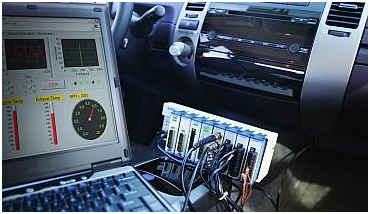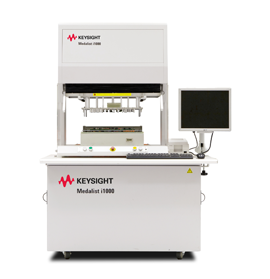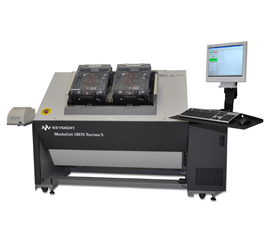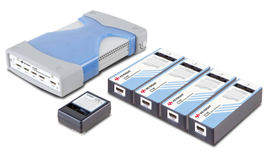 Increase in Automotive Electronics Drives Need for Sophisticated Test Equipment.
Increase in Automotive Electronics Drives Need for Sophisticated Test Equipment.
Electronics represents a significant portion of a vehicle’s cost. Electronics control everything from the operation of the engine and brakes, to the control of passenger safety, fuel efficiency, vehicle stability comfort, and security. To accomplish these tasks, vehicles are equipped with a vast array of sensors, actuators, cameras, satellite navigation devices, communications equipment, and advanced electronic components. Electronic control units (ECUs) are used to manage all these computing resources, leading to complex data processing systems that must reliably communicate with and integrate multiple elements under harsh conditions over the life of the vehicle in order to provide a safe and efficient driving experience.
Vehicle system testing is undergoing radical changes driven by need for greater energy efficiency, reduced emissions and improved safety for both vehicle occupants and pedestrians.


 The connectivity of functions in the automobile is increasing with every new generation of vehicles with different bus systems being deployed at the same time. In addition, high requirements regarding robustness as well as the increased capability of electronics within safety-relevant areas of driving dynamics and driver assistant systems are getting more and more important. These long-term trends raise the necessity to meet standards for process conformity, quality assurance, production and development.
The connectivity of functions in the automobile is increasing with every new generation of vehicles with different bus systems being deployed at the same time. In addition, high requirements regarding robustness as well as the increased capability of electronics within safety-relevant areas of driving dynamics and driver assistant systems are getting more and more important. These long-term trends raise the necessity to meet standards for process conformity, quality assurance, production and development.
The tremendous adoption of electronic functionalities in passenger vehicles has created opportunities for electronic testing and validation services in the automotive industries. Automotive OEMs are increasingly employing electronic test equipment in plants to manufacture reliable end products that satisfy customer interests along with the mandates imposed by the environmental and safety regulations. Electronic testing is an indispensable entity in various departments within the automotive industry. The R&D department leverages the testing equipment in proving and testing the design, and the design validation team uses computer controlled test systems to test the electronic modules. Production demands high throughput test systems with high performance to price ratio to ratify the finished electronics systems in the manufacturing plants.

Harsha Vardhan U, Manager – Applications Engg & Business Development, VTI Instruments pointed key factors for the growth of Automotive Testing. He says, “Safety , Comfort, and Fuel efficiency have been driving automobile OEMs and its vendors to provide better products to market, at faster pace. Also the growth of hybrid and fully electric vehicles required the Automobile OEMs to design and validate every aspect of the vehicle, since it differs a lot from the traditional models. Combined, these factors are driving the demand for turn-key test solutions which are flexible, faster and multi-purpose use.”
He adds, “Solution oriented products and software will be playing a major role in addressing the current and future challenges in the automotive testing and measurement field. This requires test instrumentation suppliers to focus on domain, and have software solutions that addresses customer needs, at higher level. Our hardware solutions are based on open instrumentation standards, and thus flexible for various kinds of use. For example, our Dynamic signal acquisition hardware can be used for modal analysis, vibration tests, acoustic mapping etc,. This advantage coupled with focused software packages, like TFI (www.tfidynamics.com) will help customers to minimize the expenditure on capital equipment. Our modular approach to electronic functional test applications will provide the same advantages to vehicle electronics production test.”


Eric Wetjen – T&M marketing manager and Wensi Jin – Automotive Industry Manager at MathWorks shared their views on Automotive Testing trends.
“As embedded control systems get more and more complex, the importance of model testing early in the design phases is becoming paramount. The embedded system model must be tested to be sure it meets the requirements, and code that runs on the embedded system needs to be verified for errors. Hardware in the loop testing is also an important step in the testing of many prototype embedded designs. In addition CAN bus remains important for vehicle level testing and fleet monitoring applications. Test systems that interface over CAN bus enable test engineers to gather important test data from vehicles that are not instrumented and also enable gathering vehicle test data from production vehicles.
With the introduction of new vehicle sensors and services that connect to the Cloud, there are new challenges for automotive testing. New protocols are emerging to allow for communication from a vehicle to a central Cloud data aggregator and this communication channel needs to be modelled and verified. Advances in automotive radar are also providing new testing requirements in the high frequency RF domain.
MathWorks tools provide a means for our customers to continually test from the early design phase of development all the way through to production. Automotive customers have already adopted the Simulink model based design approach to design their embedded controllers. Test engineers then use MathWorks verification and validation (V&V) tools to test their models before production. Finally products like Data Acquisition Toolbox, Instrument Control Toolbox and Vehicle Network Toolbox allow our customers to perform system level tests on instrumented pre-production vehicles driving on a test track. Having a full chain of testing tools that goes from the earliest design phases through to production enables our customers to efficiently test and build new designs.”
For additional information, please visit: http://in.mathworks.com/solutions/test-measurement/

Mr. Arun Rajanna, Account Manager, Keysight Technologies India Pvt. Ltd. shares key automotive t&m feature requirements and main drivers.
He says, “Occupant Safety in automobiles has been one of the key drivers for designing new Automotive test and measurement solutions from Keysight divisions. Also expanded regulatory requirements for pedestrian safety and fuel economy, and the increased availability of data and information is driving the demand for cutting edge automotive test and measurement solutions..
Examples are designing Keysight systems and instruments for electronic measurements centered around Vehicle body and safety (BCM), Engine control units(ECU), Fuel control, Valve timing , Tire Pressure Monitoring system(TPMS) and complex body control.
Current challenges in the automotive test and measurement field are keeping pace with the blistering advancements in the automotive electronics industry. We need to quickly define system and instrument solutions for emerging automotive technologies such as Variable Valve-Timing, Cylinder De-activation, Direct Fuel Injection and Turbocharging with Scavenging. Future challenges would be to define test and measurement parameters for Connected Cars and complex body control and in vehicle measurements.
Keysight has a rich history of being the premier Test and measurement solutions provider right from HP labs to Agilent and now as Keysight, we continue to be the defining and premier partner who excel in our test and measurement solutions to our valued Automotive customers. Keysight has the complete range of test equipments & measurement instruments, electronics systems and solutions for Automotive Research, Development (NPI/Prototype Test), Manufacturing, Factory and repair.”
Anritsu the leading test and measurement solutions provider for Automotive segment. Wireless technologies have acquired importance during the last decade in the automotive industry, making the experience of driving safer and more comfortable. All these wireless standards, including mobile, short range wireless and navigation, help to keep the driver connected everywhere, while broadcast technologies are also important for the other passengers.
Below are key areas focused by Anritsu for Automotive Segment
Safety and Driver Aids
Aiming to ensure safety and the quickest responses from emergency services in the event of a traffic accident, an emergency call (eCall) made automatically by an involved car could save millions of lives. As soon as on-board sensors (e.g. the airbag sensors) register a serious accident, the car will automatically dial the standard emergency phone number and send vital information including location and speed.
Once that vital information is transmitted, a voice channel will be established between the call centre operator and the passengers to check their status.
Anritsu offers an eCall tester based on a complete network simulator and a software tool simulating Public Safety Answering Points (PSAP). GPS modules, on-board sensors and radar systems aiming to protect and aid the driver can be tested using Anritsu’s Spectrum Analyzers, Signal Generators or Universal Wireless Testers.
In-Vehicle Networks
The Automotive Industry is constantly increasing the presence of technology in-vehicles. With sometime more than a hundred separate control units in the modern vehicle, all generating more and more applications for informing and entertaining the passengers. All these devices, connected with each other, are constantly sending data to central computers or displays. Anritsu’s OTDR and GigE analyzers are used for ensuring the high transmission rates in all points of the in-vehicle network.
Anritsu’s Site Master and Vector Network Analyzers will easily check the proper continuity of cables and connectors.
Intelligent Transport System
ITS (Intelligent Transport Systems) refers to all types of communication inside or outside the vehicle. In the connected car environment, there are several sensors that are communicating with other vehicles and the road, including lanes and signals. Current applications, known as Car2Car, V2V or V2x include radar and eCall, but this will increase in the next few years as vehicles will be equipped with a higher number of sensors and driver aids.
Anritsu offers a complete set of instruments and compact software solutions to make M2M testing easy and in line with ITS standards, as well as 802.11p.
Electromagnetic Interference
Anritsu offers a full set of instruments for electromagnetic compatibility (EMC). Where different technologies are simultaneously operating in public frequency bands thorough EMC and EMI testing are of vital importance.
Electromagnetic interference (EMI) testing is a must before launching a product into the real wireless world. Spectrum Analyzers, near field probes and handhelds from Anritsu will ensure your product is compatible with the standards.







